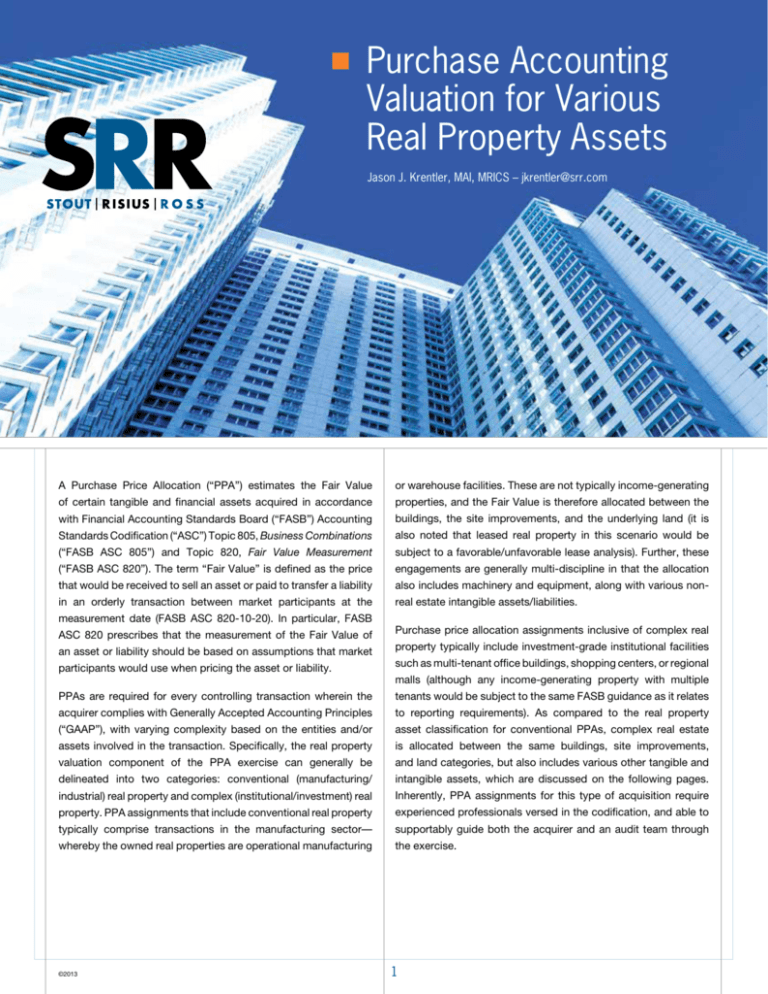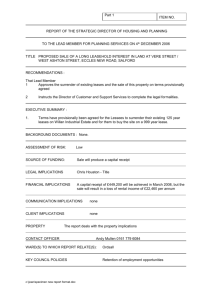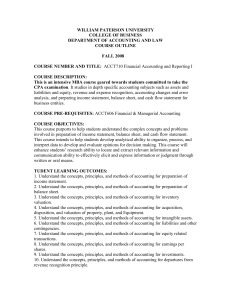Purchase Accounting Valuation for Various Real
advertisement

Purchase Accounting Valuation for Various Real Property Assets Jason J. Krentler, MAI, MRICS – jkrentler@srr.com A Purchase Price Allocation (“PPA”) estimates the Fair Value or warehouse facilities. These are not typically income-generating of certain tangible and financial assets acquired in accordance properties, and the Fair Value is therefore allocated between the with Financial Accounting Standards Board (“FASB”) Accounting buildings, the site improvements, and the underlying land (it is Standards Codification (“ASC”) Topic 805, Business Combinations also noted that leased real property in this scenario would be (“FASB ASC 805”) and Topic 820, Fair Value Measurement subject to a favorable/unfavorable lease analysis). Further, these (“FASB ASC 820”). The term “Fair Value” is defined as the price engagements are generally multi-discipline in that the allocation that would be received to sell an asset or paid to transfer a liability also includes machinery and equipment, along with various non- in an orderly transaction between market participants at the real estate intangible assets/liabilities. measurement date (FASB ASC 820-10-20). In particular, FASB ASC 820 prescribes that the measurement of the Fair Value of an asset or liability should be based on assumptions that market Purchase price allocation assignments inclusive of complex real property typically include investment-grade institutional facilities participants would use when pricing the asset or liability. such as multi-tenant office buildings, shopping centers, or regional PPAs are required for every controlling transaction wherein the tenants would be subject to the same FASB guidance as it relates acquirer complies with Generally Accepted Accounting Principles to reporting requirements). As compared to the real property (“GAAP”), with varying complexity based on the entities and/or asset classification for conventional PPAs, complex real estate assets involved in the transaction. Specifically, the real property is allocated between the same buildings, site improvements, valuation component of the PPA exercise can generally be and land categories, but also includes various other tangible and delineated into two categories: conventional (manufacturing/ intangible assets, which are discussed on the following pages. industrial) real property and complex (institutional/investment) real Inherently, PPA assignments for this type of acquisition require property. PPA assignments that include conventional real property experienced professionals versed in the codification, and able to typically comprise transactions in the manufacturing sector— supportably guide both the acquirer and an audit team through whereby the owned real properties are operational manufacturing the exercise. ©2013 malls (although any income-generating property with multiple 1 and liabilities. The genesis of these asset/ Conventional Complex Tangible Assets Tangible Assets of an institutional multi-tenant office building Buildings Site Improvements Land Buildings Site Improvements Land Unamortized Tenant Improvements or regional mall is not only purchasing the Intangible Assets/Liabilities Intangible Assets/Liabilities Favorable/Unfavorable Lease (Leased Property Only) Above-Market Leases Below-Market Leases Customer Relationships In-Place Leases Avoided Lease Origination Costs liability classifications lies in the leased fee component of the property. That is, the buyer underlying land and the bricks and mortar, it is also acquiring all lease contracts in place, along with the various implications driven by those contracts. The following example describes these additional assets and liabilities, what they represent, and how their Fair Value is accounted for. Similar to the first case, the Fair Value of all buildings, site improvements, and land Given the assets acquired and liabilities assumed, the Fair are identified and allocated. However, as income-generating Value conclusions are then compared to the total transaction properties, the appropriate methodology varies to best reflect consideration (i.e., the purchase price). To the extent that the market participant application. As such, the property is typically purchase price exceeds the Fair Value of the non-debt net working valued on an as-vacant basis via the income approach; more capital and tangible and intangible assets/liabilities, the excess specifically, a discounted cash flow is modeled to identify the value is recognized as goodwill. In the event that the Fair Values future income stream associated with the property, but under the of the tangible and intangible assets/liabilities exceeds the total hypothetical scenario of complete vacancy, so as to exclude any purchase price, the resulting gain is recognized in earnings on contribution from the leases in place (which are valued separately). the transaction date, as outlined in FASB ASC 805 for bargain This as-vacant income approach is supported by a cost approach, purchase procedures. which appropriately values the land and improvements with no consideration of leases in place. The sales comparison To further identify the specific valuation variances between approach is also employed, but primarily as support to the Fair purchase accounting for conventional and complex real estate, Value conclusion of the individual tangible and intangible assets the following two examples are presented. The first describes in aggregate. This is due to the leased fee nature of similar the analysis and presentation of an allocation assignment investment-grade transactions, in which all real property assets for a typical operational automotive manufacturing facility. The are conveyed in one bundle of rights. second example represents an asset purchase of a trophy office building by a REIT. I 1 Conventional Real Property – Tangible Assets Only n n n In this scenario, traditional appraisal theory for an owner-user industrial facility is applied. As it relates to methodology, the most relevant and applicable approaches between the sales, income, and cost approaches are utilized in the Fair Value conclusion of the property. From this point, the Fair Value conclusion is allocated However, one additional tangible asset is typically present in these complex real properties—unamortized tenant improvements. This asset category represents the benefit or cost avoidance associated with previously incurred tenant improvements. It is often calculated based on the individual tenant square footage, the concluded market tenant improvement allowance, and the remaining lease term. Intangible Assets and Liabilities Associated with Complex Real Property n n n between the buildings, site improvements, and land. The underlying land is typically valued separately, and site improvement Fair A significant variance in the appraisal process between Value is generally concluded via a cost approach. Deducting land conventional and complex real property for PPA purposes lies in the Fair Value and site improvement Fair Value results in the Fair Value presence of intangible assets and liabilities. As noted previously, component attributable to the buildings. these intangible categories tie to the acquisition of lease contracts Real Property – Tangible and I Intangible Assets and Liabilities n n n 2 Complex While the preceding paragraph typically summarizes all steps on a PPA for conventional real property, the exercise for complex real estate includes the valuation of several other assets beyond the underlying land and improvements. Intangible assets/ liabilities associated with institutional or investment-grade properties typically comprise above-market leases, below-market leases, customer relationships, in-place leases, and avoided lease origination costs. Beyond the quantification of each asset or liability, it is also necessary to understand the remaining useful life associated with each item for amortization purposes. 2 ©2013 Favorable/Unfavorable Leasehold Analysis (Above- and Avoided Lease Origination Costs - Beyond the value of avoided Below-Market Leases) - Beyond the value of the lease contracts lease-up costs, a property owner would recognize an asset in the in place, there are also potential assets or liabilities in the cost avoidance of leasing commissions and legal/marketing costs presence of lease contracts that deviate from the market. From associated with the leases in place. To that end, the unamortized the acquirer’s perspective, above-market leases are considered leasing commissions and legal/marketing costs associated with an asset in that income is attributable to the contract beyond what each individual lease should be measured. Similar to the valuation would be available in the market. To the contrary, below-market of unamortized tenant improvements, avoided lease origination lease contracts would be considered a liability via the income costs are calculated with market leasing assumptions over the impairment throughout the term of the lease. remaining term of each contract. To determine whether or not in-place leases are favorable or In summary, real property valuation for the purpose of a purchase unfavorable, contract leases and current listings of comparable price allocation is inherently different than most appraisal properties are analyzed to determine a rental rate and expense assignments, in that it requires an understanding of accounting structure typical of the market. If the contract lease rate regulations and financial reporting guidelines. Within a PPA deviates from the concluded market rate, the annual contract framework, there is further bifurcation between conventional real rent is subtracted from the annual market rent to determine the property assets (such as an operational manufacturing plant) and difference in annual cash flows for the remainder of the lease term. complex real estate (for example a class A office park). While For above-market leases, it is reasonable to assume the tenant conventional properties may follow more traditional appraisal would decline any options to extend. For below-market leases, the methodologies, complex real estate in the vein of institutional remaining lease term is typically projected to include all defined, or investment-grade assets often feature intangible assets and favorable option terms. liabilities that are not easily discernible. In these cases, it is imperative the valuation expert handling the purchase accounting nContracts with above-market rents have a positive Fair Value (i.e., an asset exists) nContracts with below-market rents have a negative Fair Value (i.e., a liability exists) Customer Relationships - Customer/tenant relationships can theoretically impact contract rental rates and other pertinent terms associated with a lease. In the instance that a favorable customer relationship exists, benefits to the landlord may include higher renewal probabilities and above-market rental rates. This is an asset category without market consensus as to treatment— while certain real property appraisers will quantify customer relationships, others assert that such relationships are almost universally absent from the market. In-Place Lease Analysis - The valuation of in-place leases is familiar with the FASB ASC 805 guidance and has the experience to supportably guide the acquirer and audit through the allocation. Jason J. Krentler, MAI, MRICS is a Director in the real estate practice within the Valuation & Financial Opinions Group at Stout Risius Ross (SRR). He is responsible for management, client liaison, business development, and appraisal production. Mr. Krentler’s concentration is in real estate valuation and advisory services, where he has 10 years of national and international appraisal, review, and management experience. Mr. Krentler can be reached at +1.248.432.1281 or jkrentler@srr.com. This article is intended for general information purposes only and is not intended to provide, and should not be used in lieu of, professional advice. The publisher assumes no liability for readers’ use of the information herein and readers are encouraged to seek professional assistance with regard to specific matters. Any conclusions or opinions are based on the individual facts and circumstances of a particular matter and therefore may not apply in other matters. All opinions expressed in these articles are those of the authors and do not necessarily reflect the views of Stout Risius Ross, Inc. or Stout Risius Ross Advisors, LLC. represents the value to the owner via the cost avoidance of leaseup costs. This component of the allocation essentially fills the gap between the as-vacant income analysis and the leased-fee income stream in place as of the transaction date. The quantification of in-place leases should include the lost rental revenue during the lease-up period—both base rent and any applicable expense reimbursements. ©2013 3




